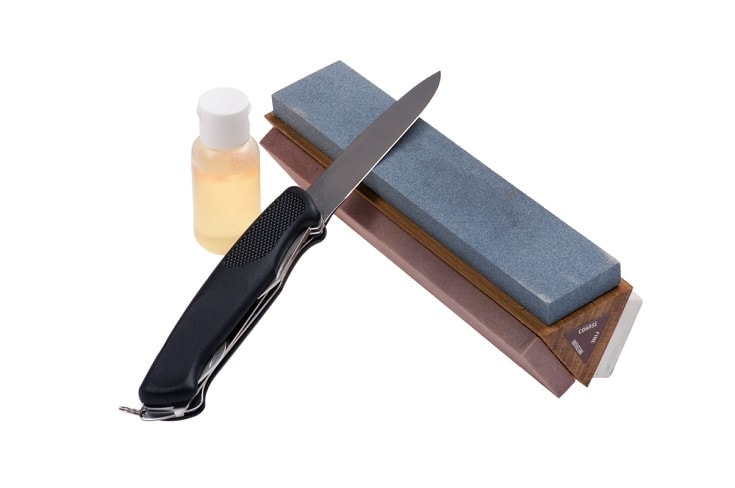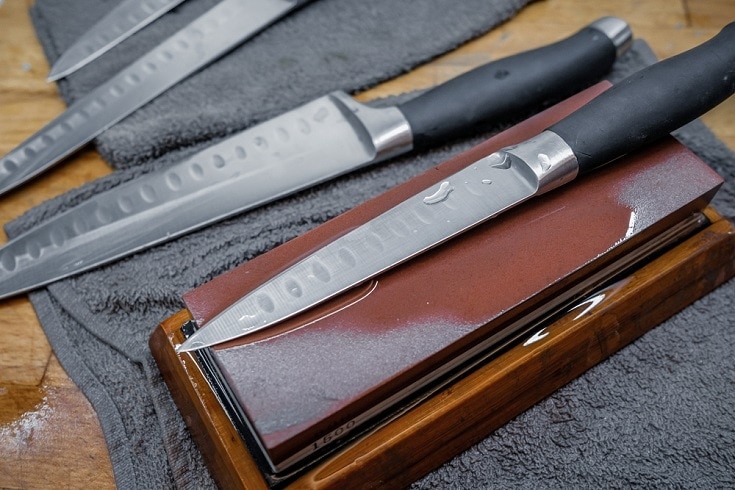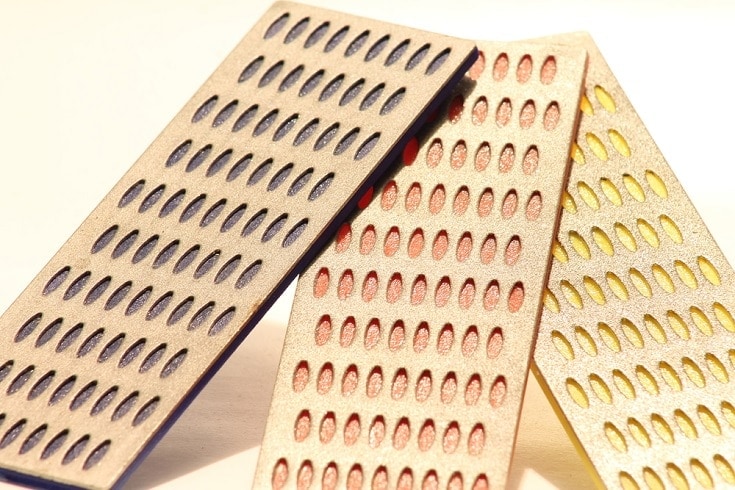3 Types of Sharpening Stones: Pros & Cons (With Pictures)
-
- Last updated:


What if a single purchase could take all your steel tools to the next level?
A sharpening stone is a great solution for knives and other tools with steel implements. A good stone can seriously improve your tools. A bad stone, however, can leave your tools worse off than ever.
Unfortunately, many handymen don’t know that much about the different kinds of sharpening stones. But that’s why we put this guide together: to help you understand your different options and the pros and cons that each option comes with.
Ready to get your next project started? Keep reading to learn all about the different types of sharpening stones!

1. Oil Stones
An oil stone is what most people think of when they think of “sharpening stone.” And if you used a sharpening stone when you were younger, chances are that it was an oil stone.
Strictly speaking, an oil stone may be made out of different kinds of materials, including Aluminum Oxide, Novaculite, and Silicon Carbide. The reason it is called an “oil” stone is that this tool uses oil to remove metal filings.

Aluminum Oxide is man-made and is generally courser than the other oil stone materials. If you like Aluminum Oxide, you will discover several different variants, including India Stones. Some handymen prefer to have multiple kinds of sharpening stones so they can deal with different kinds of steel.
Novaculite is what most oil stones come from. Novaculite itself is quarried in Arkansas, which is why these kinds of oil stones are also called Arkansas stones. Because Arkansas stones have different densities and different finishes, they are typically separated into categories such as Soft Arkansas and Hard Arkansas.
Silicon Carbide is a very fast-cutting oil stone. These stones usually come in three varieties: fine, medium, and coarse. These kinds of stones are good for that initial sharpening, but experienced handymen may need to move from this kind of stone to other types to complete the sharpening process.
Pros and Cons of Oil Stones:
Earlier, we mentioned how oil stones are the most common type of sharpening stones used by handymen. These stones have certain advantages over the competition, but they also have some drawbacks you should be aware of.
The main advantage of oil stones is that they offer a solid overall performance. These stones are very “beginner-friendly,” and if you can only have one sharpening stone, oil is a good bet.
The other primary advantage of oil stones is the price. You can typically find these stones at very competitive prices, which is perfect if you are shopping on a budget.
There is only one real drawback, but it is significant: of all the sharpening stones, oil stones cut the slowest. If you will be working on a very narrow time table, then you may need to go with another stone.
2. Water Stones

The term “water stone” may sound like a bit of a contradiction. However, these newer types of sharpening stones are becoming increasingly popular all over the world.
While it’s possible to buy natural water stones, most of the water stones available in stores are synthetic. Synthetic water stones are typically made using Aluminum Oxide, but you’ll find that water stones are softer than other stones using Aluminum Oxide. Contrary to expectations, this softness helps the stone cut faster because old material breaks off more easily and makes way for new material.
Pros and Cons of Water Stones:
Like the oil stone, water stones have their own sets of advantages and disadvantages. We’ve already discussed the primary advantage: these stones cut very fast, especially compared to oil stones. And the fact that these stones use water instead of oil to remove metal filings makes things much easier for you to clean.
What’s the catch, you ask? Just one real drawback: these stones wear down quickly (and sometimes unevenly). This means you may need to replace this sharpening stone more quickly or spend a lot of time trying to flatten the stone back into the correct shape.
3. Diamond Sharpening Stones

A “diamond sharpening stone” may sound very fancy. However, the stone in question is actually a combination of small diamonds attached to metal plates.
The diamonds provide a harder cutting material than the other stones. And you can choose from two different diamond sharpening stone styles.
The first style has holes in the diamond surface to help capture metal filings. The second style has a continuous diamond surface for when you don’t want to get any materials caught in any holes.
Generally speaking, you can find sharpening stones featuring mono-crystalline and poly-crystalline diamonds. We recommend those with mono-crystalline diamonds because they will last longer.
Pros & Cons of Diamond Sharpening Stones:
Diamond sharpening stones come out of the gate with two big advantages. The first advantage is that it sharpens very fast, which is great when you’re in a hurry. The second big advantage is that these sharpening stones stay flat for a long time compared to other types of stones.
The main disadvantage of diamond sharpening stones is something you probably saw coming: these stones are expensive! The good news is that while these diamonds aren’t cheap, this kind of sharpening stone should last a good, long time.

Featured Image Credit: Pixabay
Contents

